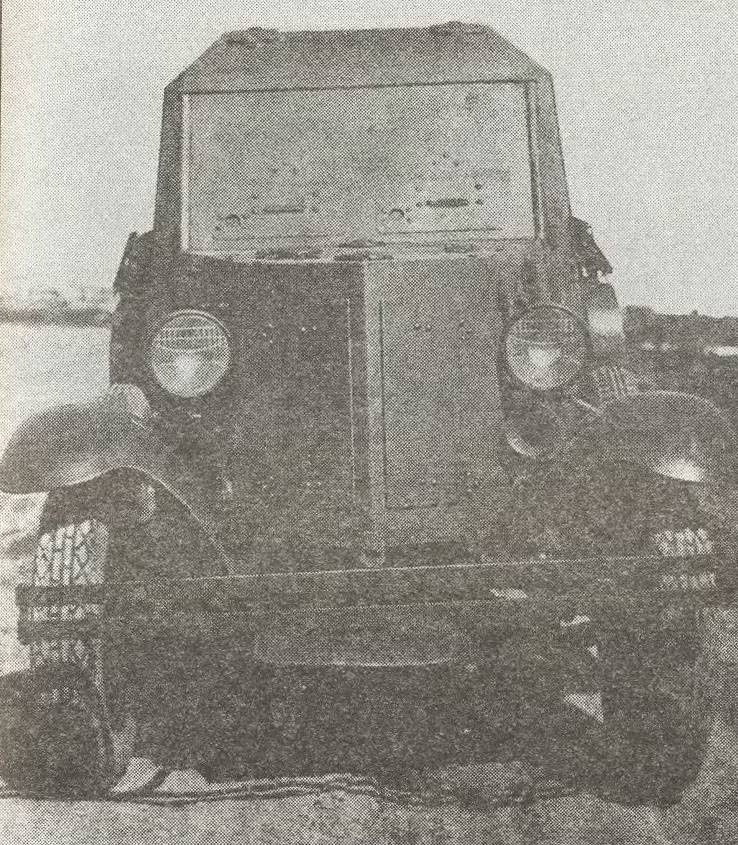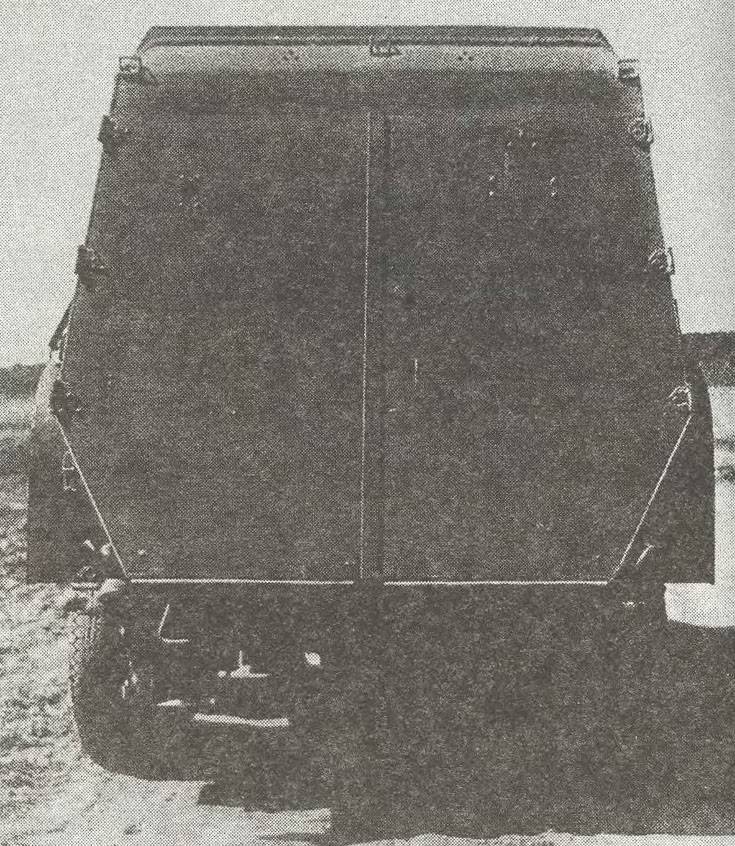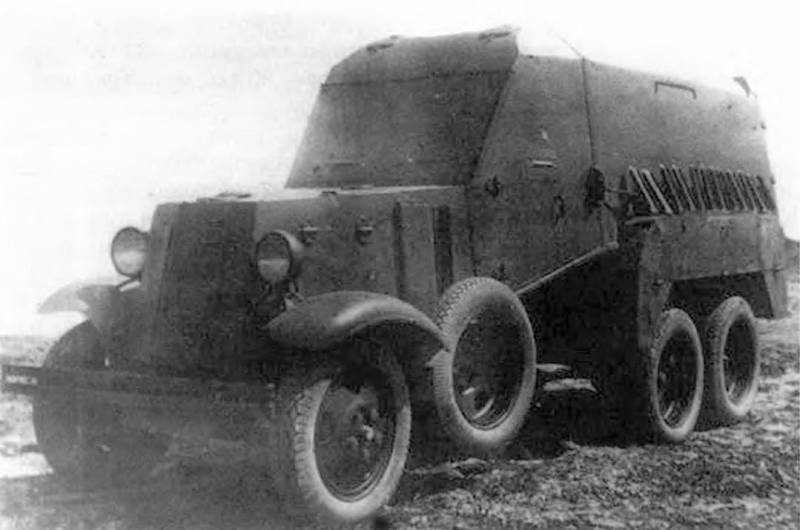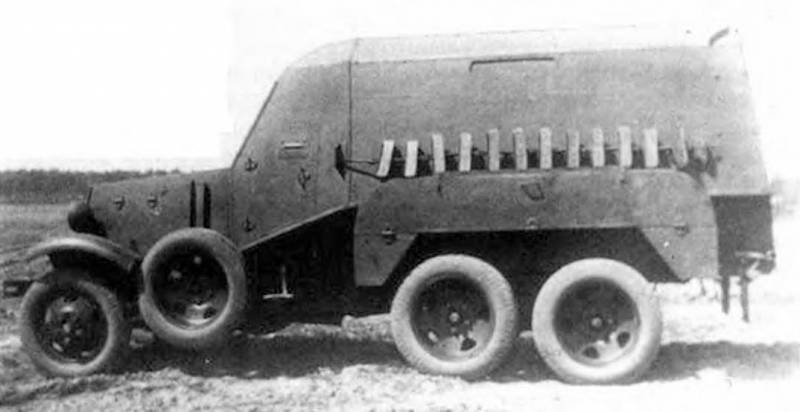BA-22 sanitary and transport armored car
One of the directions of the development of the Red Army in the thirties was the improvement of the medical service, incl. creation of new models of equipment for her. By the end of the decade, the idea of an armored medical vehicle (BMM) appeared - a special armored car capable of evacuating the wounded directly from the battlefield. An experimental vehicle of this type was designated BA-22.
Moto-medical station
In 1938 (according to other sources, in 1937), the sanitary department of the Red Army came up with an initiative to create a special sanitary and transport armored car for the removal of the wounded from the front line in conditions of intense shelling. The Armored Directorate agreed with the proposal and launched a new project. The development of BMM was entrusted to the Plant of Crushing and Grinding Equipment in Vyksa - this enterprise already had experience in creating armored cars for various purposes, although not all of its developments were successful.
By the middle of 1938, the DRO Plant prepared a BMM project based on the existing automobile chassis. Then construction began, and in September the customer was presented with a ready-made "armored moto-medical center for mechanical parts" BA-22.
In autumn and winter, factory tests were carried out in Vyksa with fine-tuning of the structure. Then the car was handed over to the ABTU of the Red Army for testing at the Research Armored Range. This stage of testing started on May 15, 1939 and ended on June 23. Based on its results, a report was prepared - listing various design flaws.
On a serial chassis
The basis for the BA-22 was the chassis of the GAZ-AAA truck, which was already used in the construction of light armored vehicles. The chassis of the frame structure had a front-engine layout and a 6x4 wheel arrangement. On top of it, it was proposed to mount an armored body of the original design.
Experienced BA-22 had a 40 hp GAZ-A gasoline engine. In the series, it was proposed to use a more powerful 50-strong M-1. The capacity of the fuel tanks is 109 liters. A standard mechanical transmission with 8 forward gears and 2 reverse gears was connected to the engine. Still used dependent suspension with leaf springs on all axles. On the two rear axles, an Overoll track chain could be used; in the stowed position, it was suspended on board the hull.
For the BA-22, an armored body with anti-bullet and anti-fragmentation protection was developed and built, corresponding to the assigned tasks. It was made of 6mm rolled armor with the same level of protection from all angles. Some of the armor parts were located at an angle to the vertical. In particular, the habitable compartment had only such protection.
The engine was covered with an armored hood with a set of hatches for the radiator and for maintenance - like other armored cars of this layout. The main part of the hull was given over to the habitable compartment with places for the crew and the wounded. On the sides of the compartment, boxes were provided for transporting property, which also served as wings.
The new armored car was supposed to carry the maximum number of sedentary or bedridden patients, which affected the design of the hull. The habitable compartment was distinguished by a significant cross-section and was almost one and a half times higher than on combat armored cars. This gave the necessary volume to accommodate the stretcher, and also allowed the orderly to stand at full height.
The frontal sheet received inspection hatches with dampers for the driver and the orderly. Any hatches, embrasures, etc. in the sides were absent. For greater convenience in loading and unloading, the entire rear of the hull was represented by one large double door. The crew should have used their own side doors.

In front of the hull there were two seats, a driver and a nurse. All other space was given to the wounded. Benches and stretcher mounts were placed along the walls of the hull. When installing the stretcher, the benches were removed from their places. BA-22 could take on board four lying wounded in two tiers, or 10 seated with full equipment, or 12 in summer uniforms - 5-6 along the sides.
Due to its special purpose, the armored car did not have its own weapons and places for its installation. Also, there were no embrasures for shooting from personal weapons... For external communication, there was a 71-TK-1 radio station on board.
The installation of the original body affected the dimensions of the car. The length remained at the level of the base chassis or armored cars based on it - 6,1 m. Width - less than 2 m. Due to the high hull, the vertical dimension of the vehicle reached 2,9 m. The weight of the vehicle with a crew and 10 wounded reached 5,24 tons. road speed exceeded 40 km / h, cruising range - 250 km.
Customer conclusion
In May-June 1939, the only experienced BA-22 was tested at the NIBT proving ground. The armored car covered 1179 km on various routes. Also, the car was tested by shelling. Based on the results of a thorough study, the new development was given a low rating. The report noted that this BMM does not meet the requirements and cannot be put into service.
The testers noted an insufficiently powerful engine. GAZ-A with a capacity of 40 hp. provided a specific power of no more than 7,7 hp. per ton, which seriously limited the mobility on rough terrain and, accordingly, did not allow solving the main tasks in the expected situation.

For a variety of reasons, the original armored hull was criticized. He was called too tall and inadequate for camouflage. The vehicle, 2,9 m high, stood out against the background of any terrain and attracted excessive attention of the enemy. The thickness and slopes of the armor were called insufficient - the body protected "only from simple bullets." Doors and hatches were called leaky.
There were also complaints about the internal equipment of the habitable compartment. It did not meet the sanitary and hygienic requirements in terms of convenience and cleanliness. This could hinder work or even threaten the health of the wounded.
According to the test results, the BA-22 was not recommended for adoption. The project was closed, and the finished car was handed over to the Scientific Research Sanitary Institute of the Red Army. This is her famous story ends. Probably, NISS studied the received BMM, drew conclusions and began to gain experience to create new equipment for sanitary and transport purposes.
Development direction
BA-22 is the first Russian armored medical vehicle. In addition, this armored car is often called the first Soviet armored personnel carrier. However, due to a number of shortcomings and inconsistencies with the basic requirements of the customer, the "moto-medical center" BA-22 was unable to realize its potential in both directions.
No new attempts were made to create medical armored vehicles. In the late thirties, industry and ABTU RKKA were loaded with other projects of higher priority. The development of the BMM concept was suspended for a long time, but the sanitary department was not left without the equipment it needed.
Soon after the abandonment of the BA-22, the forces of various enterprises developed several new ambulances based on serial chassis. From the point of view of the main performance characteristics, they, at least, were not inferior to the BA-22, but at the same time they did not have armor. With the exception of the ability to work on the front line, they were a complete and more successful replacement for a failed armored car.
This technique was most actively used during the Great Patriotic War. Together with her, any available cars and animal-drawn vehicles were used to transport the wounded. All this made it possible to promptly remove millions of wounded from the battlefield and provide them with the necessary assistance.
- Ryabov Kirill
- Solyankin A.G., Pavlov M.V., Pavlov I.V., Zheltov I.G. Domestic armored vehicles. XX century. - M .: Eksprint, 2002. - T. 1. 1905-1941, Kolomiets M.V. Armor on wheels. History of the Soviet armored car 1925-1945 - M .: Yauza, KM Strategy, Eksmo, 2007.


Information